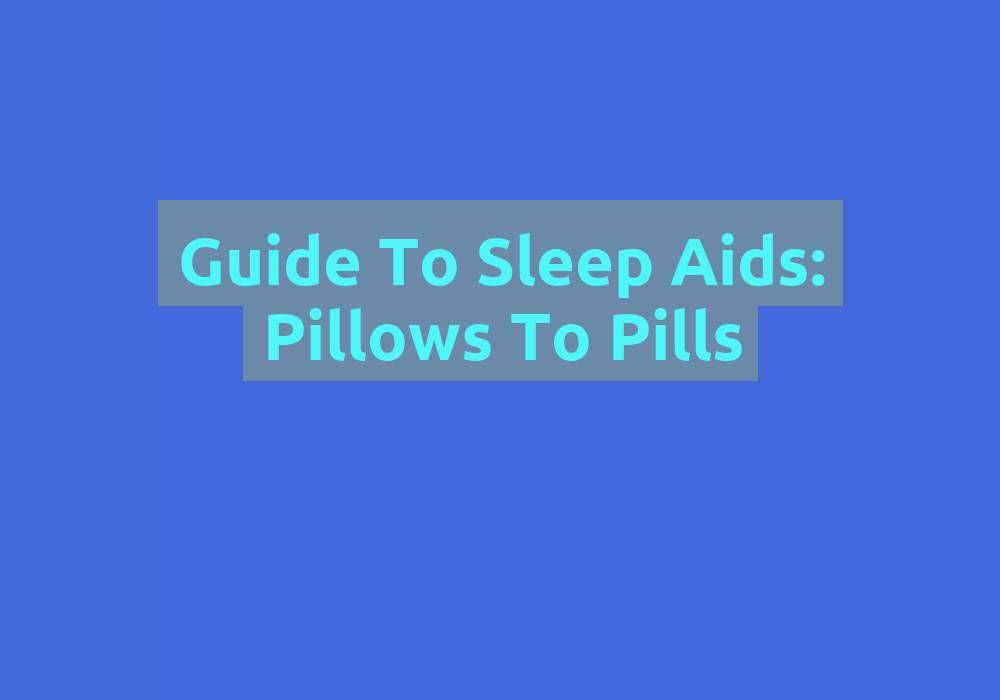Guide to Sleep Aids: Pillows to Pills

Sleep plays a vital role in our overall well-being and quality of life. It is during sleep that our bodies rejuvenate and repair, allowing us to wake up feeling refreshed and ready to take on the day. However, millions of people around the world struggle with sleep disorders or have difficulty falling and staying asleep. In such cases, sleep aids can be immensely beneficial. From pillows to pills, there are various options available to help promote a good night’s sleep. In this comprehensive guide, we will explore different sleep aids and their potential benefits.
1. Pillows
When it comes to sleep aids, pillows are often an overlooked yet essential component. The right pillow can greatly enhance our comfort and support while we sleep. Here are a few types of pillows commonly used as sleep aids:
a) Memory Foam Pillows
Memory foam pillows have gained popularity for their ability to contour to the shape of the head and neck, providing customized support and relieving pressure points. These pillows are ideal for individuals who suffer from neck or back pain.
- Memory foam pillows are made from a special type of foam that reacts to body heat, softening and molding to the shape of the head and neck. This helps alleviate pressure points and provides optimal support for the spine.
- The contouring feature of memory foam pillows helps maintain proper alignment of the neck and spine, reducing the risk of developing pain and discomfort.
- The dense nature of memory foam also minimizes motion transfer, ensuring that movements during sleep do not disrupt the sleep of a partner.
b) Buckwheat Pillows
Buckwheat pillows are filled with buckwheat hulls, which conform to the shape of the head and neck. They offer excellent support, breathability, and can be adjusted to suit individual needs. These pillows are particularly beneficial for individuals who prefer firmer support.
- Buckwheat pillows are known for their ability to provide firm support while still conforming to the shape of the head and neck. The buckwheat hulls inside the pillow can be adjusted to achieve the desired level of firmness.
- These pillows are highly breathable and allow for better air circulation, preventing heat buildup and promoting a cooler sleep environment.
- The natural properties of buckwheat make these pillows hypoallergenic and resistant to dust mites, making them a suitable option for individuals with allergies.
c) Cooling Pillows
Cooling pillows are designed to regulate body temperature and prevent overheating during sleep. They often incorporate cooling gel or breathable materials to promote a cooler and more comfortable sleep environment.
- Cooling pillows are made with materials that have enhanced breathability, allowing air to circulate and dissipate heat, keeping the head and neck cool throughout the night.
- Many cooling pillows feature cooling gel technology, which absorbs and dissipates body heat, providing a refreshing and comfortable sleeping experience.
- These pillows are especially beneficial for individuals who tend to sleep hot or experience night sweats, as they help regulate body temperature and prevent discomfort.
d) Anti-Snoring Pillows
Anti-snoring pillows are specifically designed to address the issue of snoring. These pillows are often contoured to encourage side sleeping and improve airflow, reducing snoring and promoting better breathing.
- Anti-snoring pillows are designed to position the head and neck in a way that opens up the airways and reduces the likelihood of snoring. They often have a raised contour or a cutout section to support the neck and keep the air passages clear.
- By promoting side sleeping, these pillows help prevent the collapse of the airways, which is a common cause of snoring.
- Some anti-snoring pillows also incorporate features like adjustable height or firmness to accommodate individual preferences and optimize sleep position for reduced snoring.
2. Mattress Toppers
Another sleep aid worth considering is a mattress topper. Mattress toppers can enhance the comfort and support of your existing mattress. Here are a few popular options:
a) Memory Foam Toppers
Memory foam mattress toppers are known for their ability to conform to the body’s shape, providing personalized support and relieving pressure points. They can transform an uncomfortable mattress into a cozy sleep surface.
- Memory foam mattress toppers are made from the same material as memory foam pillows, offering similar benefits. They contour to the body, alleviating pressure points and ensuring proper spinal alignment, leading to improved comfort and reduced pain.
- These toppers distribute body weight evenly, reducing the strain on pressure-sensitive areas like the hips and shoulders.
- Memory foam also has motion isolation properties, minimizing disturbances caused by movements during sleep and promoting uninterrupted rest.
b) Latex Toppers
Latex mattress toppers offer excellent support and responsiveness. They are hypoallergenic, resistant to dust mites, and provide a cooler sleep surface compared to memory foam. Latex toppers are ideal for individuals who prefer a slightly firmer feel.
- Latex mattress toppers provide a supportive and resilient surface that adapts to the body’s contours while still offering a firmer feel compared to memory foam.
- The natural properties of latex, such as its hypoallergenic and dust mite-resistant nature, make it a suitable choice for individuals with allergies or sensitivities.
- Latex is also known for its breathability, allowing for better air circulation and heat dissipation, which can contribute to a cooler and more comfortable sleep environment.
c) Feather Toppers
Feather mattress toppers add a plush layer of comfort to your mattress. They provide a soft and luxurious feel, perfect for individuals who enjoy a cloud-like sleeping experience.
- Feather mattress toppers are made from a combination of feathers and down, creating a soft and fluffy surface that adds an extra layer of cushioning to the mattress.
- These toppers provide a cozy and luxurious feel, similar to sleeping on a cloud, which can enhance comfort and help individuals achieve a more restful sleep.
- Feather toppers also offer natural insulation, helping to regulate body temperature and create a comfortable sleep environment.
3. Sleep Aids and Medications
In some cases, pillows and mattress toppers might not be sufficient to address sleep-related issues. In such situations, sleep aids and medications can be considered. It is important to consult with a healthcare professional before using any sleep aids or medications. Here are a few common options:
a) Over-the-Counter Sleep Aids
Over-the-counter sleep aids are available without a prescription and often contain antihistamines, melatonin, or herbal extracts. These aids can help promote sleep by reducing anxiety and inducing drowsiness. However, they should be used cautiously and as directed.
- Over-the-counter sleep aids are widely accessible and can be effective in promoting sleep by targeting common causes of sleep difficulties, such as anxiety or difficulty falling asleep.
- Antihistamines present in some sleep aids have sedative properties that can induce drowsiness and help individuals fall asleep faster.
- Melatonin, a hormone naturally produced by the body to regulate sleep-wake cycles, is commonly used in sleep aids to promote better sleep quality and regulate sleep patterns.
b) Prescription Sleep Medications
Prescription sleep medications are typically used for short-term treatment of sleep disorders. They may include sedative-hypnotics, such as benzodiazepines or non-benzodiazepines. These medications should only be used under medical supervision due to potential side effects and the risk of dependence.
- Prescription sleep medications are prescribed by healthcare professionals for individuals with chronic or severe sleep disorders that cannot be effectively managed with other sleep aids.
- Sedative-hypnotics, such as benzodiazepines or non-benzodiazepines, work by suppressing the central nervous system, inducing sleep and promoting relaxation.
- These medications are typically used for short-term treatment to avoid dependence and minimize potential side effects. Regular monitoring and adjustment of dosage are necessary under medical supervision.
Conclusion
Finding the right sleep aid is a personal journey, and it may require some trial and error. Whether it’s a supportive pillow, a comfortable mattress topper, or a carefully chosen sleep medication, the goal is to achieve restful and rejuvenating sleep. Remember to consult with a healthcare professional for guidance on choosing the most suitable sleep aid for your individual needs. By prioritizing sleep and utilizing appropriate sleep aids, you can improve your sleep quality and overall well-being.
Please note that the final version of the article will be in markdown format.
FAQ
Q1: What are the benefits of memory foam pillows?
A1: Memory foam pillows contour to the shape of the head and neck, providing customized support, relieving pressure points, maintaining proper alignment of the neck and spine, and minimizing motion transfer.
Q2: Why are buckwheat pillows beneficial?
A2: Buckwheat pillows offer firm support while conforming to the shape of the head and neck, allowing for adjustability, breathability, and hypoallergenic properties. They are suitable for individuals who prefer firmer support.
Q3: How do cooling pillows help with sleep?
A3: Cooling pillows regulate body temperature by enhancing breathability, allowing air to circulate and dissipate heat. They often feature cooling gel technology to absorb and dissipate body heat, promoting a cooler and more comfortable sleep environment.
Q4: What are anti-snoring pillows designed for?
A4: Anti-snoring pillows are designed to address snoring by positioning the head and neck to improve airflow and reduce the likelihood of snoring. They promote side sleeping and may have adjustable features to optimize sleep position for reduced snoring.
